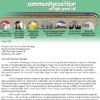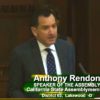There was an important hearing held July 31st which will determine which evidence could be used in the upcoming case called, John Tos, Aaron Fukuda and Kings County vs. the California High-Speed Rail Authority.
This is the second half of the Tos case set for hearing on February 11, 2016. Two years ago project opponents received a favorable ruling for the first part of their case, which challenged the adequacy of the Authority’s funding plan. However, this ruling was overturned July 31, 2014, at the Appellate Level, which ruled it was too early to decide the issues ruled on by Judge Kenny. The appeal court decision advised project opponents they would have to wait until the second funding plan to challenge the high-speed rail project. This would be when construction using bond funding was about to be spent Non-bond fund money, in particular cap-and-trade funds and a small amount of federal grant funds are being spent today on early construction. The Rail Authority has not used bond funds to construct early phases of the Central Valley project and has not yet filed the second funding plan the Appellate Court spoke about.
This time project opponents will attempt to prove three things that:
1. The rail project cannot make the two hour and forty minute trip times required in Prop 1A;
2. The blended system is not part of the bond act;
3. The lack of financial viability for the overall project is questionable.
Last year Judge Kenny granted Defendants’ motion (High-Speed Rail Authority) to limit the scope of evidence at trial with the Administrative Record. This included the record for the Court’s writ proceedings of May 31, 2013, together with the administrative record before the Authority for the 2014 Business Plan. However the court allowed both parties to supplement the record if mutually agreed.
Prior to the hearing, Attorney General’s office agreed to allow many pieces of evidence to be added to the record but the hearing was about remaining pieces of evidence some of which would make it easier for the project opponents to prove their case.
Though this case is not a California Environmental Quality Act (CEQA) case, it is called a Mandamus case but like CEQA the administrative record provides the evidence that was before the governmental agency before making their decisions. You cannot simply submit evidence that just attempts to prove that decisions made were wrong. This was in a ruling in a case called, (Western States Petroleum Assn. v. Superior Court (1995) 9 Cal.4th 559, 579.)
Primarily two issues were argued at this hearing. One regarding submission of travel time analysis documents prepared by project opponents and the other issue was whether or not expert declarations submitted by the opponents back in 2013 would be allowed to supplement the record.
The Attorney General’s office lead by Deputy Attorney Sharon O’Grady wants to limit the evidence to what was decided in formal proceedings by the Rail Authority such as the 2012 and 2014 Business Plans. The AG’s office believes in fact that all decisions come from formal proceedings and official documents such as business plans and environmental documents.
The AG’s office did not want to allow opponents’ expert declarations into evidence. She believes if they had been presented as commentary for the 2014 business plan they would have become part of the administrative record. The opponents led by Attorney’s Stuart Flashman and Michael Brady believe that the declarations were presented to the Authority’s attorneys back in 2013 and that should suffice as delivery to the Authority. They argued that this case wasn’t about the 2014 Business Plan, only the time frame for which evidence could be presented. It appeared the judge was having doubts about combining notification to the Rail Authority via a court case vs. officially submitting documents to the Rail Authority for consideration.
Decisions by the Authority: Formal and informal
There is a key difference of opinion concerning how the High-Speed Rail Authority makes decisions. The Attorney General’s office believes all decisions are made in public view in official documents such as business plans and environmental studies. On the other hand, project opponents believe that in addition to those, there are informal decisions made out of the public eye, which is why they believe the current Administrative record is inadequate and should be supplemented. The idea is with informal decisions, the public is not permitted to challenge the Authority’s thinking by making comment before key decisions are made.
Example: The Authority’s attorneys submitted a declaration from their Chief Program Manager, an engineer named Frank Vacca and in that declaration it states the project can make the time required in Prop I. This declaration was never debated, presented or discussed at a board meeting.
When questioned by the judge, the Attorney General’s office represented by Deputy Attorney General, Sharon O’Grady agreed with the judge’s inquiry that the Vacca document was indeed a staffer who provided this analysis. But when the Judge asked if that made it insignificant, she replied no, it proved that in some way they could make the 2 hour and 40 minute travel time from Los Angeles to San Francisco but that it wasn’t a final decision and that the Authority could change their minds later about the ultimate route.
On one hand the AG’s office does not believe the content of the Vacca declaration was a decision by the Rail Authority but on the other hand it was important enough to be in a court declaration defending the time requirements of Prop 1A, a suit against the High-Speed Rail Authority. And it was important enough to have this analysis reviewed by the Independent Peer Review Group and important enough to have their analysis shared with the California state legislature.
It is true that the absolute final design of the route over the mountains between Bakersfield and Palmdale has not yet been decided however opponents argued that the Authority couldn’t change the route which guaranteed a station in Palmdale. They first determined that in a 1999 alternatives report that they would cross the treacherous Tehachapi Mountain range between Bakersfield and Palmdale.
In addition later studies done after the Prop 1A vote also confirmed hat the Authority intended to go over the Tehachapi Mountains. This was evident in their alternative selections in the February 2, 2012 Board Meeting. See page 65 of the meeting transcript, which starts the discussion of this routing.
Basically opponents argue that the Authority has made a decision that currently precludes compliance with Proposition 1A since crossing that mountain range would require such slower speeds getting up and down the mountain. Going down the grade was so steep, beyond the Authority’s technical guidelines, that the train would have to slowly cascade down the mountain in order to safely decend. Slower speeds translate into slower travel time. The Vacca analysis on the other hand showed a straight shot down the mountain at 220 miles per hour.
And as for the AG’s objection that no formal decision had been made yet while true, project opponents disagreed that this discussion was premature for determination based on a case which ruled though a formal decision was not yet made when you can see that a decision is a foregone conclusion, it’s enough to declare the action ready for determination; particularly so in the snap shot approach Judge Kenny ordered.
Opponents gave another example of an informal decision that was never determined by formal action by the Authority yet promised to communities by way of presentations by the Authority. They promised that in urban cities that the train would not go faster than 125 mph. The opponents listed approximately 40 cities that these presentations were made. The AG allowed those records to supplement the Administrative record.
When questioned by the judge as to who made that decision to allow those presentations to be made, Deputy AG Sharon O’Grady did not know but said regardless the Authority could change their mind, no final decision had been made yet.
The point is project opponents believe that if the train slowed to 125 mph as they pass through urban cities, they would lose more time. Combining other travel time losses challenges the Prop 1A travel time requirements.
If the judge agrees that informal decisions were made and demonstrates the current condition of the project, he’ll decide whether he believes the project conforms with Prop 1A or not. Without this snap shot approach which the judge said he would use, if judicial review was not permitted until the very end after all decisions were made, it would be too late to object.
Opponents’ Co-counsel Stuart Flashman believes that a key factor will be the Judge’s decision to supplement the record if he agrees that the Authority made informal decisions behind closed doors and not in public view.
Co-counsel Michael Brady, also on the opponents side says, “The issues are complex, much evidence to be considered and we look forward to the judge’s decisions.” He expects the court’s ruling will occur sometime in the next two weeks.




